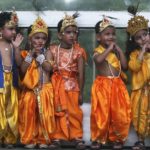 Hinduism is a religion of festivities. Pomp, color, dance and music, assortment of delicacies, traditional costumes and merry making are usually associated with most Hindu festivals. Janmashtami- celebration of Lord Krishna’s birth, epitomizing the grandeur of Hindu festivities was observed in India on September 1. The Janmashtami celebrations, like most Hindu festivals, have come to highlight some specific dimensions of Hinduism portraying it as a religion that is ‘modern’ and ‘convenient’. The authenticity of these depictions can be challenged but it is the image of Hinduism as a religion marked by joyful festivities that feeds popular perception. Whether it is the Ganesh festival in Maharashtra or the Durga Puja Pandals in Bengal or the Navratri Dandiya nights in Gujarat, Hinduism is glamorized in the mainstream media.
Hinduism is a religion of festivities. Pomp, color, dance and music, assortment of delicacies, traditional costumes and merry making are usually associated with most Hindu festivals. Janmashtami- celebration of Lord Krishna’s birth, epitomizing the grandeur of Hindu festivities was observed in India on September 1. The Janmashtami celebrations, like most Hindu festivals, have come to highlight some specific dimensions of Hinduism portraying it as a religion that is ‘modern’ and ‘convenient’. The authenticity of these depictions can be challenged but it is the image of Hinduism as a religion marked by joyful festivities that feeds popular perception. Whether it is the Ganesh festival in Maharashtra or the Durga Puja Pandals in Bengal or the Navratri Dandiya nights in Gujarat, Hinduism is glamorized in the mainstream media.
Janmashtami celebrations this year support the contention that Hindu festivals are becoming more pompous and embracing several not-so-traditional forms of celebration. This year lakhs of Govindas used the virtual world to hop from one Dahi-Handi to the next. Dahi-Handi is a part of Janmashtami celebrations where an earthen pot containing butter is suspended from ropes; groups of individuals called Govinda Mandals form a human pyramid to break the pot and win the prize usually running into huge sums of cash. Google maps on dahikala.com were used by govinda mandals to navigate their way across the city of Mumbai in search of the Dahi-Handis. Last year the highest prize for breaking a Dahi-Handi was Rs. 21 lakhs and is expected to have shot up three times this year. Since many political groups and parties are involved in sponsoring the prize money there have been concerns of using the Dahi-Handi festivity was a vote harnessing tactic.
The most interesting dimension of the Dahi-Handi celebration is its cultural appeal across religious divisions. Leading English daily in India reported earlier this week: “Khuda Husain has religiously fasted through the Ramzan month. But, this 20-year-old Badlapur bus driver is more excited about Lord Krishna’s birthday on Thursday, when he will stand shoulder to shoulder with his Maharashtrian friends as part of a dahi handi pyramid.” Formation of the pyramid and winning the cash prize is viewed more as an economic opportunity and issue of respective group’s dominance rather than a purely religious celebration.
Almost every television series in India has devoted episodes to the celebration of Janmashtami during the past week. Irrespective of the nature of the series, humour, drama or reality show, cradling the idol of Lord Krishna or breaking Dahi-handis has featured on television screens everyday.
Secular educational institutions have also been engaged in celebrating Janmashtami. Teachers at EuroKids, a pre-school education provider, handed goodies like flutes to children during the Janmashtami.
The mix of culture, politics, entertainment and religion has come to characterize most Hindu festivals like Janmashtami. The prominence of religion in this new mix is perhaps the least. The cultural festivities and entertainment value are strongly emphasized making purely religious occasions like Janmashtami more like social fairs. The religious practice where Hindus fast through the Janmashtami day and make elaborate preparations for worshipping the idols is only casually mentioned. The tradition where Janmashtami is celebrated as a continuum to the birth celebrations of Lord Balram (elder brother of Lord Krishna) and Goddess Radha (Lord Krishna’s eternal consort according to Hindu mythology) does not receive popular attention. Thousands of temples across India observe the Bhagavad Week, leading to the final celebration of Janmashtami. During this week the holy scripture of Srimad Bhagavad is read during the day time by devotees.
By relegating the religious dimensions of the festival to the background, Janmashtami becomes a social occasion which can occupy the secular public space without arousing suspicion among members of other faiths. Janmashtami celebrations in India are a specimen of how religion can be private but religious festivities can be celebrated in public space without creating antagonisms.